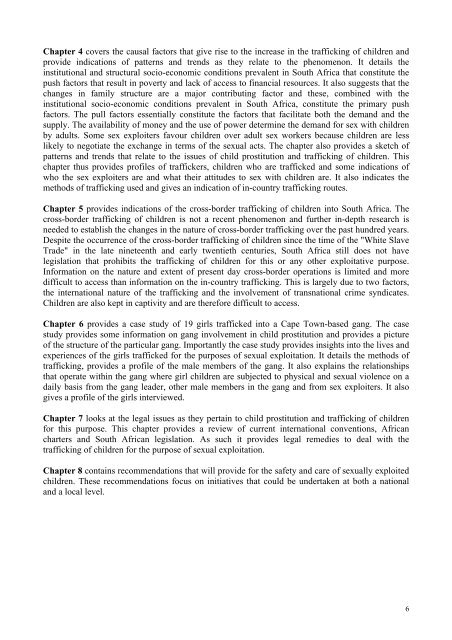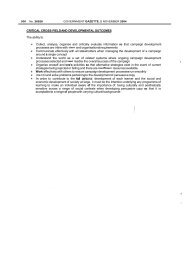The trafficking of children for purposes of sexual exploitation
The trafficking of children for purposes of sexual exploitation
The trafficking of children for purposes of sexual exploitation
You also want an ePaper? Increase the reach of your titles
YUMPU automatically turns print PDFs into web optimized ePapers that Google loves.
Chapter 4 covers the causal factors that give rise to the increase in the <strong>trafficking</strong> <strong>of</strong> <strong>children</strong> and<br />
provide indications <strong>of</strong> patterns and trends as they relate to the phenomenon. It details the<br />
institutional and structural socio-economic conditions prevalent in South Africa that constitute the<br />
push factors that result in poverty and lack <strong>of</strong> access to financial resources. It also suggests that the<br />
changes in family structure are a major contributing factor and these, combined with the<br />
institutional socio-economic conditions prevalent in South Africa, constitute the primary push<br />
factors. <strong>The</strong> pull factors essentially constitute the factors that facilitate both the demand and the<br />
supply. <strong>The</strong> availability <strong>of</strong> money and the use <strong>of</strong> power determine the demand <strong>for</strong> sex with <strong>children</strong><br />
by adults. Some sex exploiters favour <strong>children</strong> over adult sex workers because <strong>children</strong> are less<br />
likely to negotiate the exchange in terms <strong>of</strong> the <strong>sexual</strong> acts. <strong>The</strong> chapter also provides a sketch <strong>of</strong><br />
patterns and trends that relate to the issues <strong>of</strong> child prostitution and <strong>trafficking</strong> <strong>of</strong> <strong>children</strong>. This<br />
chapter thus provides pr<strong>of</strong>iles <strong>of</strong> traffickers, <strong>children</strong> who are trafficked and some indications <strong>of</strong><br />
who the sex exploiters are and what their attitudes to sex with <strong>children</strong> are. It also indicates the<br />
methods <strong>of</strong> <strong>trafficking</strong> used and gives an indication <strong>of</strong> in-country <strong>trafficking</strong> routes.<br />
Chapter 5 provides indications <strong>of</strong> the cross-border <strong>trafficking</strong> <strong>of</strong> <strong>children</strong> into South Africa. <strong>The</strong><br />
cross-border <strong>trafficking</strong> <strong>of</strong> <strong>children</strong> is not a recent phenomenon and further in-depth research is<br />
needed to establish the changes in the nature <strong>of</strong> cross-border <strong>trafficking</strong> over the past hundred years.<br />
Despite the occurrence <strong>of</strong> the cross-border <strong>trafficking</strong> <strong>of</strong> <strong>children</strong> since the time <strong>of</strong> the "White Slave<br />
Trade" in the late nineteenth and early twentieth centuries, South Africa still does not have<br />
legislation that prohibits the <strong>trafficking</strong> <strong>of</strong> <strong>children</strong> <strong>for</strong> this or any other exploitative purpose.<br />
In<strong>for</strong>mation on the nature and extent <strong>of</strong> present day cross-border operations is limited and more<br />
difficult to access than in<strong>for</strong>mation on the in-country <strong>trafficking</strong>. This is largely due to two factors,<br />
the international nature <strong>of</strong> the <strong>trafficking</strong> and the involvement <strong>of</strong> transnational crime syndicates.<br />
Children are also kept in captivity and are there<strong>for</strong>e difficult to access.<br />
Chapter 6 provides a case study <strong>of</strong> 19 girls trafficked into a Cape Town-based gang. <strong>The</strong> case<br />
study provides some in<strong>for</strong>mation on gang involvement in child prostitution and provides a picture<br />
<strong>of</strong> the structure <strong>of</strong> the particular gang. Importantly the case study provides insights into the lives and<br />
experiences <strong>of</strong> the girls trafficked <strong>for</strong> the <strong>purposes</strong> <strong>of</strong> <strong>sexual</strong> <strong>exploitation</strong>. It details the methods <strong>of</strong><br />
<strong>trafficking</strong>, provides a pr<strong>of</strong>ile <strong>of</strong> the male members <strong>of</strong> the gang. It also explains the relationships<br />
that operate within the gang where girl <strong>children</strong> are subjected to physical and <strong>sexual</strong> violence on a<br />
daily basis from the gang leader, other male members in the gang and from sex exploiters. It also<br />
gives a pr<strong>of</strong>ile <strong>of</strong> the girls interviewed.<br />
Chapter 7 looks at the legal issues as they pertain to child prostitution and <strong>trafficking</strong> <strong>of</strong> <strong>children</strong><br />
<strong>for</strong> this purpose. This chapter provides a review <strong>of</strong> current international conventions, African<br />
charters and South African legislation. As such it provides legal remedies to deal with the<br />
<strong>trafficking</strong> <strong>of</strong> <strong>children</strong> <strong>for</strong> the purpose <strong>of</strong> <strong>sexual</strong> <strong>exploitation</strong>.<br />
Chapter 8 contains recommendations that will provide <strong>for</strong> the safety and care <strong>of</strong> <strong>sexual</strong>ly exploited<br />
<strong>children</strong>. <strong>The</strong>se recommendations focus on initiatives that could be undertaken at both a national<br />
and a local level.<br />
6
















